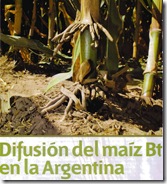 This project aims to understand how technological innovations that will shape agriculture over the next decades are adopted by members of a social system. As part of this goal, Carolina Favre and Carlos Laciana analyzed the historical adoption in Argentina of “Bt maize”—genetically-modified maize tolerant to attacks by Lepidoptera larvae (caterpillars). Their work was published in the June 2009 issue of AACREA Magazine.
This project aims to understand how technological innovations that will shape agriculture over the next decades are adopted by members of a social system. As part of this goal, Carolina Favre and Carlos Laciana analyzed the historical adoption in Argentina of “Bt maize”—genetically-modified maize tolerant to attacks by Lepidoptera larvae (caterpillars). Their work was published in the June 2009 issue of AACREA Magazine. The area planted with Bt maize in Argentina grew quickly after its market introduction in 1998, and apparently stabilized at 60-65% of the total maize area since 2004/5, the most recent publically-available figure. However, there are differences in adoption between our two study regions. According to data from seed companies, Bt maize adoption in northern Córdoba was 80-90% in 2007/8, whereas the corresponding proportion was only 60-70% in northern Buenos Aires. Differences between sites are apparently associated with the higher frequency of late-planting dates (due to lower rainfall during the winter) in northern Córdoba. As summer progresses, the number of individuals in successive generations of stem-boring insects increases, therefore late-planted maize in Córdoba will be more likely to suffer damage.
Favre and Laciana also collected information about maize hybrids actually used by AACREA farmers and interviewed technical advisors for two CREA groups (details withheld due to privacy considerations). Even though both groups were in the same region—and thus shared agroecological conditions—their adoption patterns were quite different. Group A showed an earlier adoption of Bt maize, whereas Group B took much longer. The differences between groups may be tied to strong influence from each group’s technical advisor. In Group A, the technical advisor was the same throughout the period studied, and had a consistently positive opinion of the innovation. In contrast, the technical advisor who coordinated Group B until 2001 was not supportive of Bt technology, and this was reflected in a low proportion of adoption; when a new advisor arrived, most Group B members started using Bt technology. These results suggest that social interactions, and particularly opinions from a trusted, influential source such as a group advisor, can play a strong role in technology adoption trajectories.
 |  |
| Carolina Favre and Carlos Laciana, authors of the study on Bt maize adoption. |
